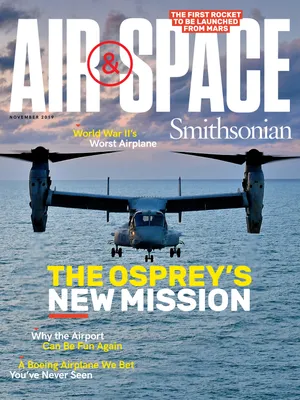This C-130 Pilot Trainee Loves His Job, and Here’s Why
“When you’re working, you don’t feel like you’re working.”
:focal(403x175:404x176)/https://tf-cmsv2-smithsonianmag-media.s3.amazonaws.com/filer/ab/7f/ab7f9ce4-4a1c-4680-bfe8-35b1a86b5978/lenoch.jpg)
The job: The 169th Airlift Squadron provides airlift support to the U.S. Air Force. “There will never be a dull moment in the C-130,” says Lenoch. “We can drop personnel, vehicles, or supplies. The C-130 is known to be commonly fired upon by surface-to-air threats, which is alarming but also exciting.”
Earliest influence: “My father, airshow pilot Vlado Lenoch. My father had flown a P-51 Mustang ever since I was born. I did not have a math or science major; I was a journalism and German dual major. My dad was an aeronautical engineering major, and got his master’s degree from MIT. You can’t possibly live up to that if you’re not good at math in the seventh grade.” But Lenoch’s dad encouraged him, and, after getting his private pilot’s license, he took his dad’s advice and applied to the Air National Guard.
The warbird advantage: “For some reason I had an easy time withstanding Gs in the T-6. I think having been surrounded by aviation all my life—honestly, it was a very spoiled upbringing, being exposed to all those warbirds. In the T-6, I could withstand 5 Gs without even doing the anti-G straining maneuver; by contrast, I had heard of other students starting to gray out at 3 Gs. It was one less thing I had to focus on.”
Skills needed for the job: Prior to qualifying on the C-130, Lenoch trained in the Raytheon T-1 Jayhawk and the Beechcraft T-6 Texan II.
In primary training, he found the T-1 the bigger challenge. “It’s always challenging when there are a number of aircraft in the pattern,” says Lenoch. “I remember one day especially, flying the T-1, and there were terrible wind gusts. The T-1 is a bear to control, and it takes an incredible amount of effort from the pilot to tame the aircraft. I was just coming to grips with how to fly the T-1 and was struggling. I was cleared for landing, and I was looking at my instruments rather than at the pattern, because for all of my previous approaches, the instructor told me I was off speed or too low. During this final approach, the instructor called ‘Go around.’ I learned in the debrief that I failed the flight because a Learjet was on the runway and had not taxied clear. It was frustrating, but I’ve never done anything like that again.”
Plans for the future: “As I serve in the Air National Guard, I’ll build experience at the unit in order to become the best tactical airlifter I possibly can. I love to fly because when you’re working you don’t feel like you’re working, and when you’re working, you feel like you’re traveling. That’s why I see flying as the perfect career for me.”
Advice for aspiring pilots: “The Air National Guard offers the widest range of career opportunities and flexibility, from part-time to full-time to traditional Guardsman.”
